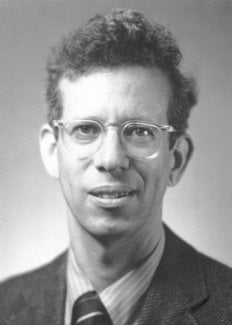Howard M. Temin
Biographical

I was born on December 10, 1934 in Philadelphia, Pennsylvania, United States of America, the second of three sons of Annette and Henry Temin. My father was an attorney, and my mother has been continually active in civic affairs, especially educational ones. My older brother, Michael, is also an attorney in Philadelphia, and my younger brother, Peter, is a Professor of Economics at the Massachusetts Institute of Technology, Cambridge, Mass.
I received my elementary and high school education in the public schools of Philadelphia. My specific interest in biological research was focused by summers (1949-1952) spent in a program for high school students at the Jackson Laboratory in Bar Harbor, Maine, and a summer (1953) spent at the Institute for Cancer Research in Philadelphia. I attended Swarthmore College from 1951 to 1955, majoring and minoring in biology in the honors program. After another summer (1955) at the Jackson Laboratory, I became a graduate student in biology at the California Institute of Technology in Pasadena, California, majoring in experimental embryology. After a year and a half, I changed my major to animal virology, becoming a graduate student in the laboratory of Professor Renato Dulbecco. My doctoral thesis was on Rous sarcoma virus. Much of my early work on this virus was carried out with the dose collaboration of Dr. Harry Rubin, then a postdoctoral fellow in Professor Dulbecco’s laboratory. At Cal Tech, I was also greatly influenced by Professor Max Delbrück and by Dr. Matthew Meselson. After finishing my Ph.D. degree in 1959, I remained for an additional year in Professor Dulbecco’s laboratory as a postdoctoral fellow. In that year, I performed the experiments that led to the formulation in the same year of the provirus hypothesis for Rous sarcoma virus.
In 1960, I moved to Madison as an Assistant Professor in the McArdle Laboratory for Cancer Research, which is also the Department of Oncology, in the Medical School, The University of Wisconsin-Madison. My first laboratory was in the basement, with a sump in my tissue culture lab and with steam pipes for the entire building in my biochemistry lab. Here I performed the experiments that led in 1964 to my formulating the DNA provirus hypothesis. In the fall of 1964, the entire department moved to a new building. I became successively Associate Professor, Full Professor, Wisconsin Alumni Research Foundation Professor of Cancer Research, and, in 1974, American Cancer Society Professor of Viral Oncology and Cell Biology. From 1964 to 1974, I also held a Research Career Development Award from the National Cancer Institute.
During my first years at Wisconsin, I worked with only two technicians. My first postdoctoral fellow joined me in 1963, and my first graduate student, in 1965. I had no more than two or three postdoctoral fellows and graduate students at one time until about 1968.
During the late 1960’s, about half of my time was spent in studying the control of multiplication of uninfected and Rous sarcoma virus-infected cells in culture. This work led to my appreciation of the role of specific serum factors in the control of cell multiplication and the demonstration that a multiplication-stimulating factor in calf serum for chicken fibroblasts was the same as somatomedin.
I serve on the editorial boards of several journals, including the Journal of Cellular Physiology, the Journal of Virology, and the Proceedings of the National Academy of Sciences U.S.A. I have also been a member of the Virology Study Section of the National Institutes of Health. In addition, I do much other paper and grant reviewing.
Since the general acceptance of the DNA provirus hypothesis in 1970, I have received many honors, including the Warren Triennial Prize (with David Baltimore); the Pap Award of the Papanicolaou Institute, Miami, Florida; the Bertner Award, M. D. Anderson Hospital and Tumor Institute, Houston, Texas; the U. S. Steel Foundation Award in Molecular Biology, National Academy of Sciences U.S.A.; the American Chemical Society Award in Enzyme Chemistry; the Griffuel Prize, Association Developpment Recherche Cancer, Villejuif, France; the G.H.A. Clowes Award, American Association for Cancer Research; the Gairdner International Award (with David Baltimore); the Albert Lasker Award in Basic Medical Research; and honorary degrees from Swarthmore College and New York Medical College. I have also presented several honorary lectures. I am a fellow of the American Academy of Arts and Sciences and a member of the National Academy of Sciences, U.S.A.
In 1962 I married Rayla Greenberg of Brooklyn, New York, a population geneticist. She has been a constant source of support and warmth. We have two daughters, Sarah Beth and Miriam.
This autobiography/biography was written at the time of the award and later published in the book series Les Prix Nobel/ Nobel Lectures/The Nobel Prizes. The information is sometimes updated with an addendum submitted by the Laureate.
Howard M. Temin died on 9 February 1994.
Nobel Prizes and laureates
Six prizes were awarded for achievements that have conferred the greatest benefit to humankind. The 12 laureates' work and discoveries range from proteins' structures and machine learning to fighting for a world free of nuclear weapons.
See them all presented here.
